凹凸紋理映射
關于凹凸映射的原理請參閱凹凸映射(Bump
Map)實現原理。
凹凸紋理映射是一種紋理混合方法,它可以創建三維物體復雜的紋理外觀表面。普通的紋理映射只能模擬比較平滑的三維物體表面,難以顯示表面高低起伏、凹凸不平的效果。凹凸紋理映射能夠通過一張表示物體表面凹凸程度的高度圖(稱為凹凸紋理),對另一張表示物體表面環境映射的紋理圖的紋理坐標進行相應的干擾,經過干擾的紋理坐標將應用于環境映射,從而產生凹凸不平的顯示效果。凹凸紋理映射通常由三張紋理映射圖組成,第一張紋理圖表示物體表面原始紋理顏色,第二張凹凸紋理圖表示物體表面凹凸的高度起伏值,用來對下一張環境紋理圖坐標進行干擾,第三張紋理圖表示周圍鏡面反射或漫反射光照的環境光照映射圖。凹凸紋理映射的紋理映射流程如下圖所示:
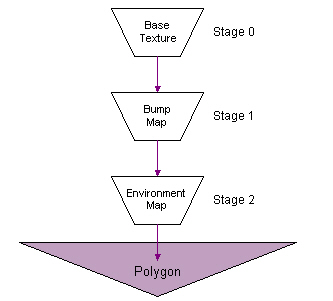
檢查硬件設備
在使用凹凸紋理映射之前,應查詢當前的Direct3D設備是否支持D3DTEXOPCAPS_BUMPENVMAP或D3DTEXOPCAPS_BUMPENVMAPLUMINANCE多層紋理混合,以及當前設備是否支持3層紋理映射。
BOOL SupportsBumpMapping()
{
D3DCAPS9 d3dCaps;
d3dDevice->GetDeviceCaps( &d3dCaps );
// Does this device support the two bump mapping blend operations?
if ( 0 == d3dCaps.TextureOpCaps & ( D3DTEXOPCAPS_BUMPENVMAP | D3DTEXOPCAPS_BUMPENVMAPLUMINANCE ))
return FALSE;
// Does this device support up to three blending stages?
if( d3dCaps.MaxTextureBlendStages < 3 )
return FALSE;
return TRUE;
}
如果當前硬件不支持上面的任何一項,程序框架會自動轉而使用參考設備。
凹凸紋理生成
Direct3D的凹凸紋理被用來表示物體表面相鄰像素的高度差,它的每個紋理元素由表示水平相鄰像素高度差的Du、表示垂直相鄰像素高度差的Dv以及表示該點亮度的L組成(某些凹凸紋理像素格式可以不包含L)。下表列出了Direct3D支持的凹凸紋理像素格式:
|
凹凸紋理像素格式 |
說明 |
|
D3DFMT_V8U8 |
每個像素由16位整數表示,分別由8位整數表示Du和Dv |
|
D3DFMT_L6V5U5 |
每個像素由16位整數表示,6位整數表示L,分別由5位整數表示Du和Dv |
|
D3DFMT_X8L8V8U8 |
每個像素由32位整數表示,包括8位保留位、8位L、8位Du、8位Dv |
|
D3DFMT_V16U16 |
每個像素由32位整數表示,分別由16位整數表示Du和Dv |
|
D3DFMT_Q8W8V8U8 |
每個像素由32位整數表示,分別由8位整數表示Q、W、V、U |
|
D3DFMT_CxV8U8 |
壓縮像素格式,每個像素由16位整數表示,即8位Du和8位Dv,另外C
= sqrt(1 - Du2 - Dv2 ) |
通常情況下,可以載入一張表示物體表面圖像高度的紋理圖,通過計算高度圖水平相鄰和垂直相鄰元素的高度差來生成凹凸紋理,也可以通過程序生成凹凸紋理,這里根據紋理圖來生成凹凸紋理,代碼如下:
//--------------------------------------------------------------------------------------
// Create bump texture from height map texture.
//--------------------------------------------------------------------------------------
HRESULT CreateBumpTexture(IDirect3DDevice9* device)
{
HRESULT hr;
D3DSURFACE_DESC surface_desc;
g_height_map_texture->GetLevelDesc(0, &surface_desc);
V_RETURN(device->CreateTexture(surface_desc.Width, surface_desc.Height, 1, 0, D3DFMT_X8L8V8U8, D3DPOOL_MANAGED,
&g_bump_map_texture, NULL));
D3DLOCKED_RECT locked_rect;
g_height_map_texture->LockRect(0, &locked_rect, NULL, 0);
DWORD src_pitch = (DWORD) locked_rect.Pitch;
BYTE* src_row_top = (BYTE*) locked_rect.pBits;
BYTE* src_row_cur = src_row_top;
BYTE* src_row_bot = src_row_top + src_pitch * (surface_desc.Height - 1);
g_bump_map_texture->LockRect(0, &locked_rect, NULL, 0);
DWORD dest_pitch = (DWORD) locked_rect.Pitch;
BYTE* dest_row_top = (BYTE*) locked_rect.pBits;
BYTE* dest_row_cur = dest_row_top;
// iterate through all lines
for(DWORD y = 0; y < surface_desc.Height; y++)
{
BYTE* src_pixel_cur;
BYTE* src_pixel_up;
BYTE* src_pixel_below;
BYTE* dest_pixel;
src_pixel_cur = src_row_cur;
if(y == 0)
src_pixel_up = src_row_bot;
else
src_pixel_up = src_row_cur - src_pitch;
if(y == surface_desc.Height - 1)
src_pixel_below = src_row_top;
else
src_pixel_below = src_row_cur + src_pitch;
dest_pixel = dest_row_cur;
// iterate through all columns in current line
for(DWORD x = 0; x < surface_desc.Width; x++)
{
BYTE src_pixel_left, src_pixel_right;
if(x == 0)
src_pixel_left = *(src_row_cur + (surface_desc.Width - 4));
else
src_pixel_left = *(src_pixel_cur - 4);
if(x == surface_desc.Width - 1)
src_pixel_right = *src_row_cur;
else
src_pixel_right = *(src_pixel_cur + 4);
BYTE du = BYTE(src_pixel_left - src_pixel_right);
BYTE dv = BYTE(src_pixel_up - src_pixel_below);
// the luminance bump value
BYTE u_lumi = (*src_pixel_cur > 1) ? 63 : 127;
*dest_pixel++ = du;
*dest_pixel++ = dv;
*dest_pixel++ = u_lumi;
*dest_pixel++ = 0;
// move one pixel to the right
src_pixel_cur += 4;
src_pixel_up += 4;
src_pixel_below += 4;
}
// move to the next line
src_row_cur += src_pitch;
dest_row_cur += dest_pitch;
}
g_bump_map_texture->UnlockRect(0);
g_height_map_texture->UnlockRect(0);
return S_OK;
}
凹凸紋理設置
凹凸紋理映射通常使用3層紋理:物體原始紋理、由原始紋理高度圖生成的凹凸紋理、環境紋理,對應于多層紋理混合的0、1、2層。指定當前紋理層狀態為D3DTOP_BUMPENVMAP或D3DTOP_BUMPENVMAPLUMINANCE可設置當前紋理層為凹凸紋理,例如:
pd3dDevice->SetTexture(1, g_bump_map_texture);
pd3dDevice->SetTextureStageState(1, D3DTSS_COLOROP, D3DTOP_BUMPENVMAP);
或
pd3dDevice->SetTexture(1, g_bump_map_texture);
pd3dDevice->SetTextureStageState(1, D3DTSS_COLOROP, D3DTOP_BUMPENVMAPLUMINANCE);
紋理狀態D3DTOP_BUMPENVMAP和D3DTOP_BUMPENVMAPLUMINANCE表示兩種不同的凹凸紋理映射方法。紋理狀態D3DTOP_BUMPENVMAPLUMINANCE表示在凹凸紋理中包含凹凸紋理亮度值L,L將與下一紋理層的紋理顏色相乘作為最后輸出的紋理顏色。紋理狀態D3DTOP_BUMPENVMAP默認亮度值L為1,即不改變下一紋理層的紋理顏色。
這里分別使用了3層紋理貼圖,如下所示:
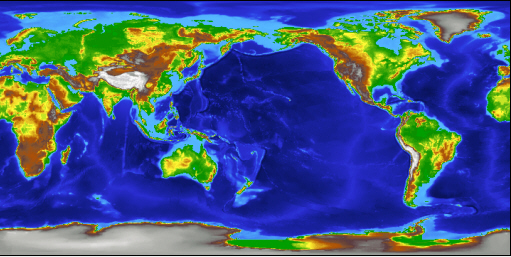
原始紋理
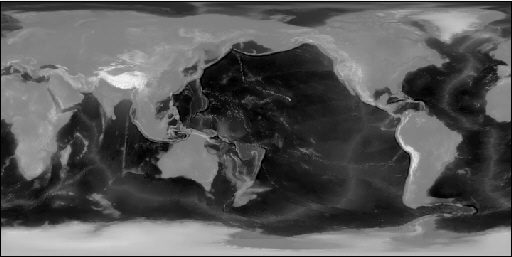
原始紋理高度圖
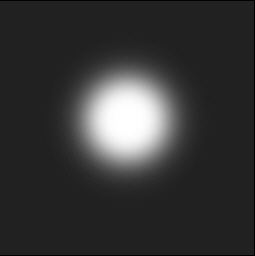
環境紋理貼圖
Direct3D可設置凹凸紋理矩陣,對凹凸紋理中的每個紋理元素值(Dv、Du,即對于下一紋理層中的每個紋理坐標的擾動值)進行坐標變換:
Du' = Du * M00
+ Dv * M10
Dv' = Dv * M01
+ Dv * M11
凹凸紋理的每個紋理元素Dv、Du與一個2
x 2的凹凸矩陣相乘,其結果Dv、Du對下一紋理層中的每個紋理元素的紋理坐標產生該數值代表的坐標擾動。2
x 2的凹凸矩陣值可由函數IDirect3DDevice9::SetTextureStageState()設置,將它的第一個參數設置為紋理層序號,第二個參數設置為D3DTSS_BUMPENVMAT00或D3DTSS_BUMPENVMAT01或D3DTSS_BUMPENVMAT10或D3DTSS_BUMPENVMAT11,分別表示凹凸矩陣的4個矩陣元素,第三個參數設置為該矩陣元素的值。紋理坐標擾動Dv、Du或Dv'、Du'的范圍介于-1
~ +1之間。
如果使用D3DTOP_BUMPENVMAPLUMINANCE計算凹凸紋理,Direct3D將使用下列方程計算凹凸紋理的亮度值L'(L'為0~255的整數,它將被用來與下一紋理層的顏色相乘,作為最后輸出的紋理顏色值)。
L' = L * S + O
其中,L為凹凸紋理元素中的亮度L值,比例系數S和偏移系數O可改變最終的亮度值。S和O可由函數IDirect3DDevice9::SetTexureStageState()設置,將它的第一個參數設置為紋理層序號,第二個參數設置為D3DTSS_BUMPENVLSCALE或D3DTSS_BUMPENVLOFFSET,分別表示凹凸紋理映射的比例系數S和偏移系數O,將第三個參數設置為相應的系數值。
設置凹凸紋理狀態的代碼如下所示:
// set texture color blend method for stage 0 (base
texture)
pd3dDevice->SetTextureStageState(0, D3DTSS_COLORARG1, D3DTA_TEXTURE);
pd3dDevice->SetTextureStageState(0, D3DTSS_COLOROP, D3DTOP_SELECTARG1);
pd3dDevice->SetSamplerState(0, D3DSAMP_MAGFILTER, D3DTEXF_LINEAR);
pd3dDevice->SetSamplerState(0, D3DSAMP_MINFILTER, D3DTEXF_LINEAR);
// set texture color blend method for stage 1 (bump map texture)
pd3dDevice->SetTexture(1, g_bump_map_texture);
pd3dDevice->SetTextureStageState(1, D3DTSS_TEXCOORDINDEX, 0);
pd3dDevice->SetTextureStageState(1, D3DTSS_COLOROP, D3DTOP_BUMPENVMAPLUMINANCE);
pd3dDevice->SetTextureStageState(1, D3DTSS_COLORARG1, D3DTA_TEXTURE);
pd3dDevice->SetTextureStageState(1, D3DTSS_COLORARG2, D3DTA_CURRENT);
pd3dDevice->SetTextureStageState(1, D3DTSS_BUMPENVMAT00, F2DW(0.8f));
pd3dDevice->SetTextureStageState(1, D3DTSS_BUMPENVMAT01, F2DW(0.0f));
pd3dDevice->SetTextureStageState(1, D3DTSS_BUMPENVMAT10, F2DW(0.0f));
pd3dDevice->SetTextureStageState(1, D3DTSS_BUMPENVMAT11, F2DW(0.8f));
pd3dDevice->SetTextureStageState(1, D3DTSS_BUMPENVLSCALE, F2DW(4.0f));
pd3dDevice->SetTextureStageState(1, D3DTSS_BUMPENVLOFFSET, F2DW(0.0f));
pd3dDevice->SetSamplerState(1, D3DSAMP_MAGFILTER, D3DTEXF_LINEAR);
pd3dDevice->SetSamplerState(1, D3DSAMP_MINFILTER, D3DTEXF_LINEAR);
// set texture color blend method for stage 2 (environment map texture)
D3DXMATRIX mat;
mat._11 = 0.5f; mat._12 = 0.0f; mat._13 = 0.0f; mat._14 = 0.0f;
mat._21 = 0.0f; mat._22 = -0.5f; mat._23 = 0.0f; mat._24 = 0.0f;
mat._31 = 0.0f; mat._32 = 0.0f; mat._33 = 1.0f; mat._34 = 0.0f;
mat._41 = 0.5f; mat._42 = 0.5f; mat._43 = 0.0f; mat._44 = 1.0f;
pd3dDevice->SetTransform(D3DTS_TEXTURE2, &mat);
pd3dDevice->SetTexture(2, g_env_map_texture);
pd3dDevice->SetTextureStageState(2, D3DTSS_TEXTURETRANSFORMFLAGS,
D3DTTFF_COUNT2);
pd3dDevice->SetTextureStageState(2, D3DTSS_TEXCOORDINDEX, D3DTSS_TCI_SPHEREMAP);
pd3dDevice->SetTextureStageState(2, D3DTSS_COLORARG1, D3DTA_TEXTURE);
pd3dDevice->SetTextureStageState(2, D3DTSS_COLORARG2, D3DTA_CURRENT);
pd3dDevice->SetTextureStageState(2, D3DTSS_COLOROP, D3DTOP_ADD);
pd3dDevice->SetSamplerState(2, D3DSAMP_MAGFILTER, D3DTEXF_LINEAR);
pd3dDevice->SetSamplerState(2, D3DSAMP_MINFILTER, D3DTEXF_LINEAR);
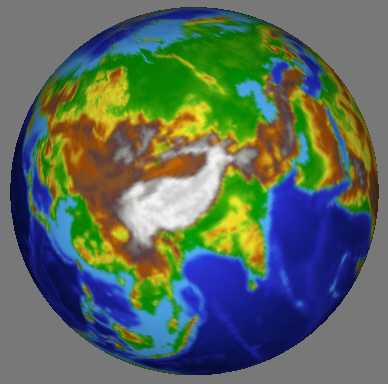
原始紋理圖
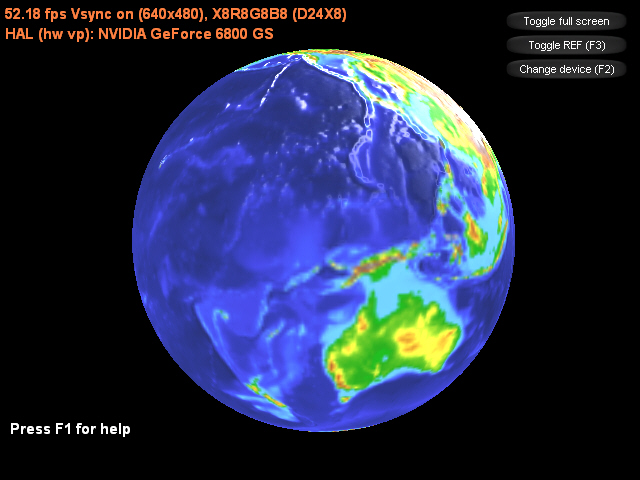
經過凹凸紋理映射后
主程序:
#include "dxstdafx.h"
#include "resource.h"
#pragma warning(disable : 4127 4995 4996)
#define release_com(p) do { if(p) { (p)->Release(); (p) = NULL; } } while(0)
#define IDC_TOGGLE_FULLSCREEN 1
#define IDC_TOGGLE_REF 2
#define IDC_CHANGE_DEVICE 3
const D3DXCOLOR FONT_COLOR(1.0f, 0.5f, 0.25f, 1.0f);
ID3DXFont* g_font;
ID3DXSprite* g_text_sprite;
bool g_show_help;
CDXUTDialogResourceManager g_dlg_resource_manager;
CD3DSettingsDlg g_settings_dlg;
CDXUTDialog g_button_dlg;
ID3DXMesh* g_mesh;
D3DMATERIAL9* g_mesh_materials;
IDirect3DTexture9** g_mesh_textures;
DWORD g_num_materials;
IDirect3DTexture9* g_env_map_texture;
IDirect3DTexture9* g_height_map_texture;
IDirect3DTexture9* g_bump_map_texture;
inline DWORD F2DW(float f) { return *((DWORD*) &f); }
//--------------------------------------------------------------------------------------
// Rejects any devices that aren't acceptable by returning false
//--------------------------------------------------------------------------------------
bool CALLBACK IsDeviceAcceptable( D3DCAPS9* pCaps, D3DFORMAT AdapterFormat,
D3DFORMAT BackBufferFormat, bool bWindowed, void* pUserContext )
{
// Typically want to skip backbuffer formats that don't support alpha blending
IDirect3D9* pD3D = DXUTGetD3DObject();
if( FAILED( pD3D->CheckDeviceFormat( pCaps->AdapterOrdinal, pCaps->DeviceType, AdapterFormat,
D3DUSAGE_QUERY_POSTPIXELSHADER_BLENDING, D3DRTYPE_TEXTURE, BackBufferFormat ) ) )
return false;
// check whether device support bump textue mapping
if((pCaps->TextureOpCaps & (D3DTEXOPCAPS_BUMPENVMAP | D3DTEXOPCAPS_BUMPENVMAPLUMINANCE)) == 0)
return false;
// check whether device support 3 level texture stage blend
if(pCaps->MaxTextureBlendStages < 3)
return false;
return true;
}
//--------------------------------------------------------------------------------------
// Before a device is created, modify the device settings as needed.
//--------------------------------------------------------------------------------------
bool CALLBACK ModifyDeviceSettings( DXUTDeviceSettings* pDeviceSettings, const D3DCAPS9* pCaps, void* pUserContext )
{
// If video card does not support hardware vertex processing, then uses sofaware vertex processing.
if((pCaps->DevCaps & D3DDEVCAPS_HWTRANSFORMANDLIGHT) == 0)
pDeviceSettings->BehaviorFlags = D3DCREATE_SOFTWARE_VERTEXPROCESSING;
static bool is_first_time = true;
if(is_first_time)
{
is_first_time = false;
// if using reference device, then pop a warning message box.
if(pDeviceSettings->DeviceType == D3DDEVTYPE_REF)
DXUTDisplaySwitchingToREFWarning();
}
return true;
}
//--------------------------------------------------------------------------------------
// Create bump texture from height map texture.
//--------------------------------------------------------------------------------------
HRESULT CreateBumpTexture(IDirect3DDevice9* device)
{
HRESULT hr;
D3DSURFACE_DESC surface_desc;
g_height_map_texture->GetLevelDesc(0, &surface_desc);
V_RETURN(device->CreateTexture(surface_desc.Width, surface_desc.Height, 1, 0, D3DFMT_X8L8V8U8, D3DPOOL_MANAGED,
&g_bump_map_texture, NULL));
D3DLOCKED_RECT locked_rect;
g_height_map_texture->LockRect(0, &locked_rect, NULL, 0);
DWORD src_pitch = (DWORD) locked_rect.Pitch;
BYTE* src_row_top = (BYTE*) locked_rect.pBits;
BYTE* src_row_cur = src_row_top;
BYTE* src_row_bot = src_row_top + src_pitch * (surface_desc.Height - 1);
g_bump_map_texture->LockRect(0, &locked_rect, NULL, 0);
DWORD dest_pitch = (DWORD) locked_rect.Pitch;
BYTE* dest_row_top = (BYTE*) locked_rect.pBits;
BYTE* dest_row_cur = dest_row_top;
// iterate through all lines
for(DWORD y = 0; y < surface_desc.Height; y++)
{
BYTE* src_pixel_cur;
BYTE* src_pixel_up;
BYTE* src_pixel_below;
BYTE* dest_pixel;
src_pixel_cur = src_row_cur;
if(y == 0)
src_pixel_up = src_row_bot;
else
src_pixel_up = src_row_cur - src_pitch;
if(y == surface_desc.Height - 1)
src_pixel_below = src_row_top;
else
src_pixel_below = src_row_cur + src_pitch;
dest_pixel = dest_row_cur;
// iterate through all columns in current line
for(DWORD x = 0; x < surface_desc.Width; x++)
{
BYTE src_pixel_left, src_pixel_right;
if(x == 0)
src_pixel_left = *(src_row_cur + (surface_desc.Width - 4));
else
src_pixel_left = *(src_pixel_cur - 4);
if(x == surface_desc.Width - 1)
src_pixel_right = *src_row_cur;
else
src_pixel_right = *(src_pixel_cur + 4);
BYTE du = BYTE(src_pixel_left - src_pixel_right);
BYTE dv = BYTE(src_pixel_up - src_pixel_below);
// the luminance bump value
BYTE u_lumi = (*src_pixel_cur > 1) ? 63 : 127;
*dest_pixel++ = du;
*dest_pixel++ = dv;
*dest_pixel++ = u_lumi;
*dest_pixel++ = 0;
// move one pixel to the right
src_pixel_cur += 4;
src_pixel_up += 4;
src_pixel_below += 4;
}
// move to the next line
src_row_cur += src_pitch;
dest_row_cur += dest_pitch;
}
g_bump_map_texture->UnlockRect(0);
g_height_map_texture->UnlockRect(0);
return S_OK;
}
//--------------------------------------------------------------------------------------
// Remove path from fullname, and convert filename from multibyte to wchar.
//--------------------------------------------------------------------------------------
void RemovePathFromFileName(LPSTR fullname, LPWSTR wfilename)
{
WCHAR wbuf[MAX_PATH] = {0};
MultiByteToWideChar(CP_ACP, 0, fullname, -1, wbuf, MAX_PATH);
LPWSTR w_last_back_slash = wcsrchr(wbuf, '\\');
if(w_last_back_slash)
lstrcpy(wfilename, ++w_last_back_slash);
else
lstrcpy(wfilename, wbuf);
}
//--------------------------------------------------------------------------------------
// Create any D3DPOOL_MANAGED resources here
//--------------------------------------------------------------------------------------
HRESULT CALLBACK OnCreateDevice( IDirect3DDevice9* pd3dDevice,
const D3DSURFACE_DESC* pBackBufferSurfaceDesc,
void* pUserContext )
{
HRESULT hr;
V_RETURN(g_dlg_resource_manager.OnCreateDevice(pd3dDevice));
V_RETURN(g_settings_dlg.OnCreateDevice(pd3dDevice));
D3DXCreateFont(pd3dDevice, 18, 0, FW_BOLD, 1, FALSE, DEFAULT_CHARSET, OUT_DEFAULT_PRECIS, DEFAULT_QUALITY,
DEFAULT_PITCH | FF_DONTCARE, L"Arial", &g_font);
V_RETURN(D3DXCreateTextureFromFile(pd3dDevice, L"HeightMap.bmp", &g_height_map_texture));
V_RETURN(D3DXCreateTextureFromFile(pd3dDevice, L"EnvMap.bmp", &g_env_map_texture));
V_RETURN(CreateBumpTexture(pd3dDevice));
ID3DXBuffer* material_buffer;
V_RETURN(D3DXLoadMeshFromXW(L"SphereEarth.x", D3DXMESH_MANAGED, pd3dDevice, NULL, &material_buffer, NULL,
&g_num_materials, &g_mesh));
D3DXMATERIAL* xmaterials = (D3DXMATERIAL*) material_buffer->GetBufferPointer();
g_mesh_materials = new D3DMATERIAL9[g_num_materials];
g_mesh_textures = new IDirect3DTexture9*[g_num_materials];
for(DWORD i = 0; i < g_num_materials; i++)
{
g_mesh_materials[i] = xmaterials[i].MatD3D;
// .x file do not save ambient data, so set it here.
g_mesh_materials[i].Ambient = g_mesh_materials[i].Diffuse;
WCHAR wfilename[MAX_PATH];
RemovePathFromFileName(xmaterials[i].pTextureFilename, wfilename);
g_mesh_textures[i] = NULL;
if(xmaterials[i].pTextureFilename != NULL && lstrlen(wfilename) > 0)
V_RETURN(D3DXCreateTextureFromFile(pd3dDevice, wfilename, &g_mesh_textures[i]));
}
material_buffer->Release();
return S_OK;
}
//--------------------------------------------------------------------------------------
// Create any D3DPOOL_DEFAULT resources here
//--------------------------------------------------------------------------------------
HRESULT CALLBACK OnResetDevice( IDirect3DDevice9* pd3dDevice,
const D3DSURFACE_DESC* pBackBufferSurfaceDesc,
void* pUserContext )
{
HRESULT hr;
V_RETURN(g_dlg_resource_manager.OnResetDevice());
V_RETURN(g_settings_dlg.OnResetDevice());
V_RETURN(g_font->OnResetDevice());
V_RETURN(D3DXCreateSprite(pd3dDevice, &g_text_sprite));
// set dialog position and size
g_button_dlg.SetLocation(pBackBufferSurfaceDesc->Width - 170, 0);
g_button_dlg.SetSize(170, 170);
// setup view matrix
D3DXMATRIX mat_view;
D3DXVECTOR3 eye(0.0f, -3.0f, 0.0f);
D3DXVECTOR3 at(0.0f, 0.0f, 0.0f);
D3DXVECTOR3 up(0.0f, 0.0f, 1.0f);
D3DXMatrixLookAtLH(&mat_view, &eye, &at, &up);
pd3dDevice->SetTransform(D3DTS_VIEW, &mat_view);
// set projection matrix
D3DXMATRIX mat_proj;
float aspect = (float)pBackBufferSurfaceDesc->Width / pBackBufferSurfaceDesc->Height;
D3DXMatrixPerspectiveFovLH(&mat_proj, D3DX_PI/4, aspect, 1.0f, 1000.0f);
pd3dDevice->SetTransform(D3DTS_PROJECTION, &mat_proj);
// set texture color blend method for stage 0 (base texture)
pd3dDevice->SetTextureStageState(0, D3DTSS_COLORARG1, D3DTA_TEXTURE);
pd3dDevice->SetTextureStageState(0, D3DTSS_COLOROP, D3DTOP_SELECTARG1);
pd3dDevice->SetSamplerState(0, D3DSAMP_MAGFILTER, D3DTEXF_LINEAR);
pd3dDevice->SetSamplerState(0, D3DSAMP_MINFILTER, D3DTEXF_LINEAR);
// set texture color blend method for stage 1 (bump map texture)
pd3dDevice->SetTexture(1, g_bump_map_texture);
pd3dDevice->SetTextureStageState(1, D3DTSS_TEXCOORDINDEX, 0);
pd3dDevice->SetTextureStageState(1, D3DTSS_COLOROP, D3DTOP_BUMPENVMAPLUMINANCE);
pd3dDevice->SetTextureStageState(1, D3DTSS_COLORARG1, D3DTA_TEXTURE);
pd3dDevice->SetTextureStageState(1, D3DTSS_COLORARG2, D3DTA_CURRENT);
pd3dDevice->SetTextureStageState(1, D3DTSS_BUMPENVMAT00, F2DW(0.8f));
pd3dDevice->SetTextureStageState(1, D3DTSS_BUMPENVMAT01, F2DW(0.0f));
pd3dDevice->SetTextureStageState(1, D3DTSS_BUMPENVMAT10, F2DW(0.0f));
pd3dDevice->SetTextureStageState(1, D3DTSS_BUMPENVMAT11, F2DW(0.8f));
pd3dDevice->SetTextureStageState(1, D3DTSS_BUMPENVLSCALE, F2DW(4.0f));
pd3dDevice->SetTextureStageState(1, D3DTSS_BUMPENVLOFFSET, F2DW(0.0f));
pd3dDevice->SetSamplerState(1, D3DSAMP_MAGFILTER, D3DTEXF_LINEAR);
pd3dDevice->SetSamplerState(1, D3DSAMP_MINFILTER, D3DTEXF_LINEAR);
// set texture color blend method for stage 2 (environment map texture)
D3DXMATRIX mat;
mat._11 = 0.5f; mat._12 = 0.0f; mat._13 = 0.0f; mat._14 = 0.0f;
mat._21 = 0.0f; mat._22 = -0.5f; mat._23 = 0.0f; mat._24 = 0.0f;
mat._31 = 0.0f; mat._32 = 0.0f; mat._33 = 1.0f; mat._34 = 0.0f;
mat._41 = 0.5f; mat._42 = 0.5f; mat._43 = 0.0f; mat._44 = 1.0f;
pd3dDevice->SetTransform(D3DTS_TEXTURE2, &mat);
pd3dDevice->SetTexture(2, g_env_map_texture);
pd3dDevice->SetTextureStageState(2, D3DTSS_TEXTURETRANSFORMFLAGS, D3DTTFF_COUNT2);
pd3dDevice->SetTextureStageState(2, D3DTSS_TEXCOORDINDEX, D3DTSS_TCI_SPHEREMAP);
pd3dDevice->SetTextureStageState(2, D3DTSS_COLORARG1, D3DTA_TEXTURE);
pd3dDevice->SetTextureStageState(2, D3DTSS_COLORARG2, D3DTA_CURRENT);
pd3dDevice->SetTextureStageState(2, D3DTSS_COLOROP, D3DTOP_ADD);
pd3dDevice->SetSamplerState(2, D3DSAMP_MAGFILTER, D3DTEXF_LINEAR);
pd3dDevice->SetSamplerState(2, D3DSAMP_MINFILTER, D3DTEXF_LINEAR);
return S_OK;
}
//--------------------------------------------------------------------------------------
// Release resources created in the OnResetDevice callback here
//--------------------------------------------------------------------------------------
void CALLBACK OnLostDevice( void* pUserContext )
{
g_dlg_resource_manager.OnLostDevice();
g_settings_dlg.OnLostDevice();
g_font->OnLostDevice();
release_com(g_text_sprite);
}
//--------------------------------------------------------------------------------------
// Release resources created in the OnCreateDevice callback here
//--------------------------------------------------------------------------------------
void CALLBACK OnDestroyDevice( void* pUserContext )
{
g_dlg_resource_manager.OnDestroyDevice();
g_settings_dlg.OnDestroyDevice();
delete[] g_mesh_materials;
g_mesh_materials = NULL;
if(g_mesh_textures)
{
for(DWORD i = 0; i < g_num_materials; i++)
release_com(g_mesh_textures[i]);
delete[] g_mesh_textures;
g_mesh_textures = NULL;
}
release_com(g_font);
release_com(g_mesh);
release_com(g_env_map_texture);
release_com(g_height_map_texture);
release_com(g_bump_map_texture);
}
//--------------------------------------------------------------------------------------
// Handle updates to the scene
//--------------------------------------------------------------------------------------
void CALLBACK OnFrameMove( IDirect3DDevice9* pd3dDevice, double fTime, float fElapsedTime, void* pUserContext )
{
D3DXMATRIX mat_world;
D3DXMatrixRotationZ(&mat_world, timeGetTime()/1000.0f);
pd3dDevice->SetTransform(D3DTS_WORLD, &mat_world);
}
//--------------------------------------------------------------------------------------
// Render the helper information
//--------------------------------------------------------------------------------------
void RenderText()
{
CDXUTTextHelper text_helper(g_font, g_text_sprite, 20);
text_helper.Begin();
// show frame and device states
text_helper.SetInsertionPos(5, 5);
text_helper.SetForegroundColor(FONT_COLOR);
text_helper.DrawTextLine( DXUTGetFrameStats(true) );
text_helper.DrawTextLine( DXUTGetDeviceStats() );
// show helper information
const D3DSURFACE_DESC* surface_desc = DXUTGetBackBufferSurfaceDesc();
if(g_show_help)
{
text_helper.SetInsertionPos(10, surface_desc->Height - 18 * 5);
text_helper.SetForegroundColor(FONT_COLOR);
text_helper.DrawTextLine(L"Controls (F1 to hide):");
text_helper.SetInsertionPos(40, surface_desc->Height - 18 * 4);
text_helper.DrawTextLine(L"Quit: ESC");
}
else
{
text_helper.SetInsertionPos(10, surface_desc->Height - 15 * 4);
text_helper.SetForegroundColor( D3DXCOLOR(1.0f, 1.0f, 1.0f, 1.0f) );
text_helper.DrawTextLine(L"Press F1 for help");
}
text_helper.End();
}
//--------------------------------------------------------------------------------------
// Render the scene
//--------------------------------------------------------------------------------------
void CALLBACK OnFrameRender( IDirect3DDevice9* pd3dDevice, double fTime, float fElapsedTime, void* pUserContext )
{
HRESULT hr;
if(g_settings_dlg.IsActive())
{
g_settings_dlg.OnRender(fElapsedTime);
return;
}
// Clear the render target and the zbuffer
V( pd3dDevice->Clear(0, NULL, D3DCLEAR_TARGET | D3DCLEAR_ZBUFFER, D3DCOLOR_ARGB(0, 0, 0, 0), 1.0f, 0) );
// Render the scene
if( SUCCEEDED( pd3dDevice->BeginScene() ) )
{
for(DWORD i = 0; i < g_num_materials; i++)
{
pd3dDevice->SetMaterial(&g_mesh_materials[i]);
pd3dDevice->SetTexture(0, g_mesh_textures[i]);
g_mesh->DrawSubset(i);
}
RenderText();
V(g_button_dlg.OnRender(fElapsedTime));
V( pd3dDevice->EndScene() );
}
}
//--------------------------------------------------------------------------------------
// Handle messages to the application
//--------------------------------------------------------------------------------------
LRESULT CALLBACK MsgProc( HWND hWnd, UINT uMsg, WPARAM wParam, LPARAM lParam,
bool* pbNoFurtherProcessing, void* pUserContext )
{
*pbNoFurtherProcessing = g_dlg_resource_manager.MsgProc(hWnd, uMsg, wParam, lParam);
if(*pbNoFurtherProcessing)
return 0;
if(g_settings_dlg.IsActive())
{
g_settings_dlg.MsgProc(hWnd, uMsg, wParam, lParam);
return 0;
}
*pbNoFurtherProcessing = g_button_dlg.MsgProc(hWnd, uMsg, wParam, lParam);
if(*pbNoFurtherProcessing)
return 0;
return 0;
}
//--------------------------------------------------------------------------------------
// Handle keybaord event
//--------------------------------------------------------------------------------------
void CALLBACK OnKeyboardProc(UINT charater, bool is_key_down, bool is_alt_down, void* user_context)
{
if(is_key_down)
{
switch(charater)
{
case VK_F1:
g_show_help = !g_show_help;
break;
}
}
}
//--------------------------------------------------------------------------------------
// Handle events for controls
//--------------------------------------------------------------------------------------
void CALLBACK OnGUIEvent(UINT event, int control_id, CDXUTControl* control, void* user_context)
{
switch(control_id)
{
case IDC_TOGGLE_FULLSCREEN:
DXUTToggleFullScreen();
break;
case IDC_TOGGLE_REF:
DXUTToggleREF();
break;
case IDC_CHANGE_DEVICE:
g_settings_dlg.SetActive(true);
break;
}
}
//--------------------------------------------------------------------------------------
// Initialize dialogs
//--------------------------------------------------------------------------------------
void InitDialogs()
{
g_settings_dlg.Init(&g_dlg_resource_manager);
g_button_dlg.Init(&g_dlg_resource_manager);
g_button_dlg.SetCallback(OnGUIEvent);
int x = 35, y = 10, width = 125, height = 22;
g_button_dlg.AddButton(IDC_TOGGLE_FULLSCREEN, L"Toggle full screen", x, y, width, height);
g_button_dlg.AddButton(IDC_TOGGLE_REF, L"Toggle REF (F3)", x, y += 24, width, height);
g_button_dlg.AddButton(IDC_CHANGE_DEVICE, L"Change device (F2)", x, y += 24, width, height, VK_F2);
}
//--------------------------------------------------------------------------------------
// Initialize everything and go into a render loop
//--------------------------------------------------------------------------------------
INT WINAPI WinMain( HINSTANCE, HINSTANCE, LPSTR, int )
{
// Enable run-time memory check for debug builds.
#if defined(DEBUG) | defined(_DEBUG)
_CrtSetDbgFlag( _CRTDBG_ALLOC_MEM_DF | _CRTDBG_LEAK_CHECK_DF );
#endif
// Set the callback functions
DXUTSetCallbackDeviceCreated( OnCreateDevice );
DXUTSetCallbackDeviceReset( OnResetDevice );
DXUTSetCallbackDeviceLost( OnLostDevice );
DXUTSetCallbackDeviceDestroyed( OnDestroyDevice );
DXUTSetCallbackMsgProc( MsgProc );
DXUTSetCallbackFrameRender( OnFrameRender );
DXUTSetCallbackFrameMove( OnFrameMove );
DXUTSetCallbackKeyboard(OnKeyboardProc);
// TODO: Perform any application-level initialization here
InitDialogs();
// Initialize DXUT and create the desired Win32 window and Direct3D device for the application
DXUTInit( true, true, true ); // Parse the command line, handle the default hotkeys, and show msgboxes
DXUTSetCursorSettings( true, true ); // Show the cursor and clip it when in full screen
DXUTCreateWindow( L"Bump Texture Mapping" );
DXUTCreateDevice( D3DADAPTER_DEFAULT, true, 640, 480, IsDeviceAcceptable, ModifyDeviceSettings );
// Start the render loop
DXUTMainLoop();
// TODO: Perform any application-level cleanup here
return DXUTGetExitCode();
}
下載示例工程